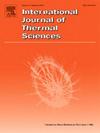Analysis of different phase change materials (PCMs) and wall material in a nano-circular space thermal energy storage (TES) system: A molecular dynamics approach
IF 4.9
2区 工程技术
Q1 ENGINEERING, MECHANICAL
International Journal of Thermal Sciences
Pub Date : 2025-04-23
DOI:10.1016/j.ijthermalsci.2025.109954
引用次数: 0
Abstract
Thermal energy storage (TES) play a vital role in overcoming the fluctuating nature of solar thermal energy. To study and understand the performance of these systems, using new techniques such as computer simulations can be useful. In this article, a specific circular nanochannel containing a phase change material (PCM) is introduced and its thermal and mass performance are investigated. By using two types of PCM and three wall metals (platinum, copper, and aluminum) the effects of changing several geometric and thermodynamic parameters are evaluated. In general, two different plans are proposed and parameters such as thermal conductivity, heat flux, charging, and discharging time are defined and evaluated. The obtained results show that the use of paraffin reduces the phase change time from 1.36 ns to 1.21 ns. Geometrical investigations also show that increasing the diameter ratio leads to a decrease in heat flux. Increasing the velocity of argon atoms in the inner tube also leads to an increase in the mobility of atoms and as a result improves the heat transfer rate. Using copper, the thermal conductivity is 54.3 % and 13.5 % higher than platinum and aluminum. The maximum heat flux for the two proposed cases is about 1500 and 1285 W/m2, respectively. Increasing the velocity of argon atoms from 0.01 Å/fs to 0.05 Å/fs leads to a decrease in the phase change time from 1.12 ns to 1.15 ns. Regarding the type of PCM, paraffin performs better than the combination of water-hydrocarbon.
纳米圆空间热储能系统中不同相变材料和壁材的分子动力学分析
热能储存(TES)在克服太阳能热能的波动性方面起着至关重要的作用。为了研究和理解这些系统的性能,使用计算机模拟等新技术可能是有用的。本文介绍了一种含相变材料的圆形纳米通道,并对其热性能和质量性能进行了研究。通过使用两种类型的PCM和三种壁金属(铂、铜和铝),评估了改变几个几何和热力学参数的影响。一般来说,提出了两种不同的方案,并定义和评估了导热系数、热流密度、充电和放电时间等参数。结果表明,石蜡的加入使相变时间从1.36 ns缩短到1.21 ns。几何研究也表明,增大直径比会导致热流密度的减小。增加内管内氩原子的速度也会导致原子迁移率的增加,从而提高传热速率。使用铜,导热系数分别比铂和铝高54.3%和13.5%。两种情况下的最大热通量分别约为1500和1285 W/m2。当氩原子速度从0.01 Å/fs增加到0.05 Å/fs时,相变时间从1.12 ns减少到1.15 ns。从PCM的类型来看,石蜡比水烃组合表现更好。
本文章由计算机程序翻译,如有差异,请以英文原文为准。
求助全文
约1分钟内获得全文
求助全文
来源期刊

International Journal of Thermal Sciences
工程技术-工程:机械
CiteScore
8.10
自引率
11.10%
发文量
531
审稿时长
55 days
期刊介绍:
The International Journal of Thermal Sciences is a journal devoted to the publication of fundamental studies on the physics of transfer processes in general, with an emphasis on thermal aspects and also applied research on various processes, energy systems and the environment. Articles are published in English and French, and are subject to peer review.
The fundamental subjects considered within the scope of the journal are:
* Heat and relevant mass transfer at all scales (nano, micro and macro) and in all types of material (heterogeneous, composites, biological,...) and fluid flow
* Forced, natural or mixed convection in reactive or non-reactive media
* Single or multi–phase fluid flow with or without phase change
* Near–and far–field radiative heat transfer
* Combined modes of heat transfer in complex systems (for example, plasmas, biological, geological,...)
* Multiscale modelling
The applied research topics include:
* Heat exchangers, heat pipes, cooling processes
* Transport phenomena taking place in industrial processes (chemical, food and agricultural, metallurgical, space and aeronautical, automobile industries)
* Nano–and micro–technology for energy, space, biosystems and devices
* Heat transport analysis in advanced systems
* Impact of energy–related processes on environment, and emerging energy systems
The study of thermophysical properties of materials and fluids, thermal measurement techniques, inverse methods, and the developments of experimental methods are within the scope of the International Journal of Thermal Sciences which also covers the modelling, and numerical methods applied to thermal transfer.
 求助内容:
求助内容: 应助结果提醒方式:
应助结果提醒方式:


